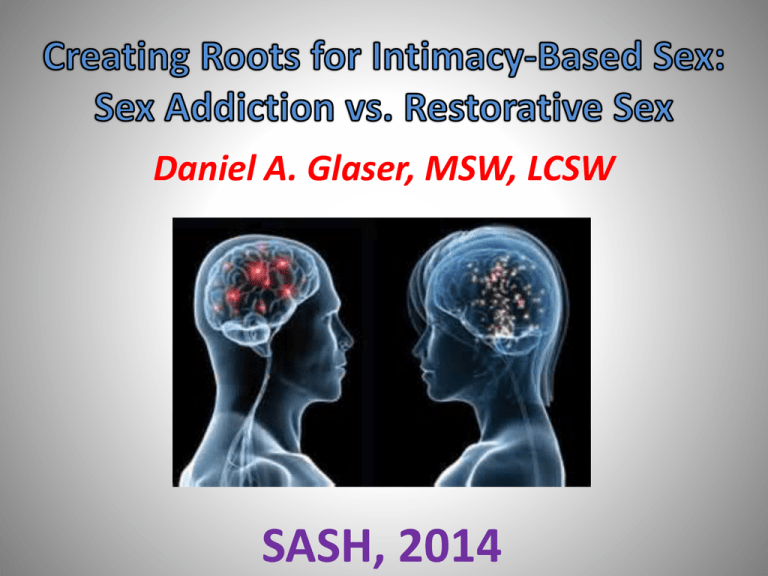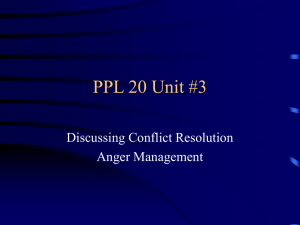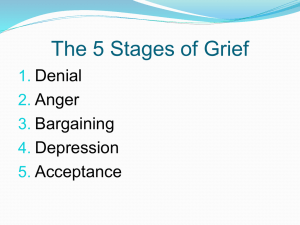
Daniel A. Glaser, MSW, LCSW
SASH, 2014
“There may be times when I’m not certain of
what to do, but there is never a time when I
don’t know what not to do.”
[Rogers, B. (2011). Addiction and Grief]
Types of Safety
Physical Safety
Mental Safety
Emotional Safety
Spiritual Safety
[Williams & Poijula (2012). The PTSD Workbook]
Self Esteem
Efficacy based > seeing
oneself as competent and
capable.
Worth based > feeling that
one is accepted and valued.
[Stete & Burke, “A Sociological Approach to Self & Identity” in Leary &
Tangney [eds.] Handbook of Self & Identity, 2003]
Ability to be aware of, control and monitor
emotional reactions, impulses, and behaviors.
Ability to repair emotional distress, usually
through taking control and renegotiating the
environment.
[Katehakis (2010). Erotic Intelligence]
Steady State
(“contextual normality”)
Temporary relief
(guilt, shame)
Stress
(“narcissistic injury”)
Pseudo or symbolic
intimacy
(fusion or libidinal &
aggressive forces)
1. Fear of fusion
2. Fear of exposure
3. Fear of rejection/abandonment
4. Fear of other’s aggressive impulses (annihilation)
5. Fear of one’s own aggressive impulses
Need for intimacy
(“libidinal forces”)
Fear of intimacy
(“aggressive forces”)
1.Physical
2.Material
3.Psychological
4.Significant others
Rewriting Negative Scripts
Choosing Path of Stress Hardy or Stressed Out
Empathy
Effective Communication
Acceptance of Self/Others
Connections and Compassion
Dealing Effectively with Mistakes
Building Islands of Competence
Developing Self Discipline & Self Control
Maintaining a Resilient Lifestyle
(Brooks & Goldstein [2004]. The Power of Resilience).
Trauma’s Impact on Self View
Identity
Body image and sensations
Internalized image of others
Values
Sense of purpose and meaning
See self as damaged goods, worthless, evil
Fragmented, compartmentalized
Feelings of guilt and shame
Negative perception of self in relation to others
Schemas: 1. Beliefs and expectations about yourself, others,
and your world.
2. Guide and organize how to process information
and how to understand life’s experience
3. Become basic rules of life
[Williams & Poijula (2012). The PTSD Workbook]
Compulsions
Compulsive Behavior
1. Comes from an identifiable source
2. Operates in a predictable pattern
3. Can be alleviated through a process of awareness, clarification and recovery
“Compulsions serve as clues to the deeper stories of our lives, an individual’s
history of emotional woundedness.”
A compulsion covers up an interior emptiness. It indicates the presence of a
control mechanism – a way of escaping something that is ultimately
unescapable and unavoidable.
Compulsions represent attempts to compensate for low self esteem and
powerlessness.
The immediate agenda of a compulsion is to maintain a sense of basic survival
in the face of what feels like certain annihilation.
The frequency of repetition depends on the depth of one’s pain and/or current
difficulties in life.
Engaging in compulsive activity creates the illusion of control.
Pursuing the illusions creates betrayal.
[Larkin & Whiting (1991)]
Dissociation
Derealization
=
“this isn’t actually happening”
Depersonalization
=
“it isn’t happening to me”
Amnesia
=
“it never happened to me”
Multiple personality =
“it happened to somebody else”
Other constellation of symptoms:
Spacing out
=
cognitive disengagement
Out of body experiences
=
physical disengagement
Analgesia
=
affective or sensory
disengagement
Challenges to Address Anger
The key to transforming anger is self awareness.
1. Spot the unrealistic expectations you have for yourself,
other people and things, that, when unmet, trigger
anger.
2. Dampen rising anger before it becomes too intense to
control. Learn the physiology of anger; how your body
reacts and how you can learn to read physical changes
so you can exert control.
3. Identify how thoughts can direct you toward or away
from an unwanted face of anger.
4. Communicate thoughts and feeling using “assertive
problem solving.”
[Nay (2012). Taking Charge of Anger: 6 Steps to Asserting Yourself Without Losing Control]
4 “P’s” of Anger
1. Your anger has a PAST – when you learned hurtful
ways of dealing with angry feelings.
2. Your anger has a PURPOSE – what you use anger
for.
3. Your anger has a PATTERN – what you think, feel,
and do over and over in response to the same
kinds of situations.
4. Your anger has a PAYOFF – what you get by being
angry and acting it out.
[Culler & Freeman-Longo. (1995). Men & Anger]
Techniques
List reasons to identify feelings.
List ways to have expressed feelings.
Keep feeling journal (log).
Do feeling lifeline.
Identify blocks to feelings.
Identify stuffed feelings.
List positive and negative effects of feelings.
Situation Perception Training (triggers, thoughts, feelings, action).
Distinguish between healing reaction and feeling response.
[Cullen & Freeman-Longo (1995). Men & Anger]
Healing Interventions
Increasing Affective Expression:
Gestalt Empty Chair
Psychodrama
Letter Writing
Art Work (collage)
Anger List
Role Play
Breathing Techniques
Bioenergetic Release
Debrief Affective Experiences
[Crowder (1995). Opening the Door.]
Healing Interventions
Visualization:
Identify “anchors” for adult self
Inner Self Visualization
Container Visualization
Safe Place
Resource Visualization
[Crowder (1995). Opening the Door.]
Boundaries
Healthy physical and emotional distance between yourself
and others.
Relationship limits.
Define where you end and where someone else begins.
Help recognize what is and what is not your responsibility in
relationships.
Let people in and keep people out.
Protect your thoughts, feelings, body, and behavior.
Help tell what’s right and what’s wrong.
Help you gain respect and show respect for others.
External Boundaries – protect your body physically and
sexually, keeping it safe and healthy.
Internal Boundaries – protect your thoughts and emotions,
protecting feelings and spirituality.
[McGee & Buddenberg (2003). Unmasking Sexual Con Games.]
Faces of Anger
Passive Aggression
Sarcasm
Cold Anger
Hostility
Aggression
[Nay (2012). Taking Charge of Anger]
Anger Log
Triggers > expectations
Thoughts > self talk
Feelings > emotions
Actions > response choices
Outcomes > personal impact/external impact
[Nay (2012). Taking Charge of Anger]
Anger Intensifiers
Sleep
Stress
Substances
Sustenance
Sickness
[Nay (2012). Taking Charge of Anger]
Personal Anger Scale
Examine the prelude to your anger in closer
detail in order to construct an anger scale that
reflects your personal pattern of anger arousal.
Note the sequence of body changes as anger
escalates, it always includes symptoms of “fight
– or – flight” anger arousal.
Describe the physical sensations experienced at
each significant increment in anger.
Link “desired behaviors” at each numbered
stage that would be initiated when anger
reached that point in the future.
[Nay (2012). Taking Charge of Anger]
Personal Anger Scale
Ratings
Physical Sensations
Desired Behaviors
0 – 20
relaxed
awareness
21 – 40
tension
manage tension, sit
down, relaxation breathing
41 – 60
rapid breathing
3 anger management tools
hit 50 = leave situation
61 – 80
standing up, pacing, “time out” = return to 40 or
clinched fists
below
81 – 100
chest pounding
should be gone
[Nay (2012). Taking Charge of Anger]
Steps of Anger Management
1. Understanding and Recognizing Anger
2. Identifying and Preparing for Anger Triggers
3. Tracking Anger Body Sensations and Dampening
Arousal
4. Identifying and Challenging Thoughts That Fuel Anger
5. Using Assertive Problem Solving
6. Sustaining New Behavior and Coping with Roadblocks
[Nay (2012). Taking Charge of Anger]
The “STOP” Model
for Anger Management
Stop > visualize stop sign, breathe, time out
Think > self talk > challenge negative thoughts
Objectify > think of facts
Plan > problem solve
[Nay (2012). Taking Charge of Anger]
Four Main Styles of Rage
Intimidator
Interrogator
Distancer
Poor-Me
[Lee, J. (2006). The Missing Peace: Solving the Anger Problem for Alcoholics,
Addicts and Those Who Love Them]
Unhealthy Ways Anger Is Expressed
Manipulation
Control
Sabotage
Jokes
Shaming
Blaming
Demeaning
Demoralizing
Criticizing
Preaching
Teaching
Judging
Analyzing
Rigidity
Verbal Threats
Word Games
All or Nothing Attitude / Black & White Thinking
[Lee, J. (2006). The Missing Peace]
Basics of Mind-Body Nurturing
1. Nurture the Body: relaxation approaches = meditation, guided
imagery, progressive muscle relaxation.
2. Nurture the Mind: cognitive restructuring, truth seeking
analysis, evidence based thinking, affirmations.
3. Nurture the Emotions: practices of emotional awareness,
expression and communication, emotional regulation, journal
writing.
4. Nurture the Self/Spirit:
- making commitments to various aspects of self (ex.
creative self or sexual self)
- realize and enact kindness toward the self.
- cultivate control, self confidence and inner peace through
imagery exercises, affirmations, self styled prayer said
inwardly.
[Domar & Dreher (2000). Self Nurture]
Self Nurture & Anger: A Healing Connection
Healthy expression of anger is synonymous with
assertiveness.
Self nurturing requires strong statements about limits,
boundaries and needs.
Suppressed anger or “amicable repressors” can produce a
variety of ill effects.
Anger is necessary in our emotional repertoire to defend and
assert ourselves.
At the other extreme, “compulsive expressers” vent fury at
the slightest provocation.
Anger is an alarm bell, a signal that something is wrong and
needs to be addressed.
Identify models for your own emotional expression.
STOP/BREATHE/REFLCT/CHOOSE guidelines enable you to
consider the most effective, assertive words and actions.
[Domar & Dreher (2000). Self Nurture]
Communication Skill Quadrant
Assertive
Aggressive
I count
I count
You count
You don’t count
Passive Aggressive
Passive
I count
I don’t count
You don’t count, but
I’m not going to tell you
You count
[Domar & Dreher (2000). Self Nurture]
Eight Methods of Relaxation
Simple guidelines for any method for eliciting the
relaxation response.
Find a quiet place
Choose regular time of day; sense of ritual keeps
commitment strong; protect your relaxation time.
No set time, most take 15 – 25 minutes.
Be flexible to mix, match and change methods.
1. Breath Focus: Shift from shallow chest5 breathing to deep
abdominal breathing.
2. Body Scan: Identify body parts; breathe in and notice tension,
breathe out and release tension.
3. PMR: - Mental focus and breathing
- Increase body tension before releasing.
[Domar & Dreher (2000). Self Nurture]
Eight Methods of Relaxation
4. Meditation: Turning attention inward, repetitive focus on
breathing and a simple word, phrase or prayer.
5. Mindfulness:
- Nourishing capacity to be in the present which engenders
gratitude for the wonders we experience through our
senses, emotions and intellect.
- Mindful walk, mindful meditation, mindful activity
6. Guided Imagery: Visual imagery is a phenomena of mind and
body, imagery can have physiologic consequences.
7. Autogenic Training: A form of self hypnosis using verbal
suggestions, which amounts to a form of progressive relaxation
for the body.
8. Yoga: A blend of physical postures, meditation and deep
breathing.
[Domar & Dreher (2000). Self Nurture]
Mini Relaxations
Portable stress managers, calm down and reclaim your
center
Short form versions of the breath-focus meditation
Uses deep abdominal (diaphragmatic) breathing
Version l
• Secure a comfortable position
• Take deep slow breath
• Place hand on abdomen, allow abdomen
to rise as you inhale
• As you exhale, notice your abdomen fall;
also notice your chest rises and falls as
does your abdomen.
[Domar & Dreher (2000). Self Nurture]
Mini Relaxations
Version 2
• Use deep abdominal breathing
• Count down from ten to zero, taking one complete breath (one
inhalation, one exhalation) with each number
Version 3
• Use deep abdominal breathing
• As you inhale, count from 1 to 4. As you exhale, count back
down from 4 to 1.
Version 4
• Use deep abdominal breathing
• Add a ten to zero count with each breath, or add a 1 to 4/ 4 to 1
count as you inhale and exhale.
• Pause for a few seconds after each in-breath and pause again
for a few seconds after each out-breath.
[Domar & Dreher (2000). Self Nurture]
Cognitive Restructuring:
The Mind Nurture Method
Listen to the voices in your head.
Record the messages that you hear.
Note the positive messages and reinforce them.
Note the harsh, critical inner voice with the negative
tape loop – a repetitive, nagging monologue of fearful
or self denigrating comments about ourselves, our
bodies, our abilities, life and prospects for happiness.
Note the “greatest hits” – specific tracks of negative self
talk that replay repetitively at the slightest provocation
or no provocation at all.
[Domar & Dreher (2000). Self Nurture]
Cognitive Restructuring:
The Mind Nurture Method
Self punishing thought patterns represent the
foundation for low self esteem and are the mental fuel
for anxiety and depression.
Defuse the punishing mind with a balanced, thoughtful,
self caring series of questions.
Cognitive restructuring bolsters self esteem by building
realistic compassion for ourselves and others.
Use evidenced based thinking.
Replace the negative thought with a kinder, more
realistic assessment.
Endless unchallenged negative thinking can lead to self
sabotage or self fulfilling prophecy.
[Domar & Dreher (2000). Self Nurture]
Nearly everyone has negative internal self
talk. Some have the internal chatter going
on almost all of the time.
[Andreas, Steve (2012). Transforming Negative Self Talk]
Internal Voices
May remind us of past failures, sorrows or
disappointments
Torture us with criticism or verbal
abuse
Describe frightening or unpleasant
future
Can cause unpleasant feelings
which may interfere with reaching
goals and achieving success
Can result in depression, anxiety
or panic attacks, violence or paranoia
Can be transformed
[Andreas, Steve (2012). Transforming Negative Self Talk]
Cognitive Process in Targeting
Dysfunctional Thoughts
(1) Identify the Situation
(2) Identify the Feelings
(3) Identify the Underlying
Thoughts
(4) Evaluate the Thought
(5) Take Action
[Mueser, Rosenberg, & Rosenberg (2009). Treatment of PTSD in Special Populations]
Format for Challenging
Self Limiting Beliefs
Where did the belief originate?
How does the belief impact/affect
life now?
What situations provoke this
belief?
What are negative consequences to the belief?
What are the positive consequence of continuing this
belief? (What am I getting? What am I avoiding?)
[Dr. Jordan & Margaret Paul (1989). From Conflict to Caring]
Emotional Expression: Keeping a Journal
Nurturing emotions should be an integral component
of broader efforts to self nurture.
Much of stress originates from within, when anger or
grief control our lives.
The answer is not to talk
ourselves out of negative
feelings, suppress them,
or even to discharge them
in explosive efforts to ventilate.
Accept full range of emotions
and stop labeling them negative.
[Domar & Dreher (2000). Self Nurture]
Affirmations & Prayer: Spirit Nurture
Affirmations can cultivate control, self confidence and
peace.
Incorporate affirmations into daily relaxation rituals.
During meditation, you can incorporate affirmations in
rhythmic concert with breathing (ex. “Still, Here”)
Prayer can aid physical and psychological healing.
Self nurturing spirituality = framework of self love that
can help to achieve tranquility, acceptance and
wisdom.
Practice prayer as you would meditation.
Choose a focus word or phrase that has spiritual
meaning for you. (Exs. Christian: Jesus, Mary, Joseph, God;
Jewish: Shalom; Islamic: Allah)
[Domar & Dreher (2000). Self Nurture]
Behavioral Addictions
Core qualities of many impulse
control disorders:
1. Repetitive or compulsive engagement in a
behavior despite adverse consequences.
2. Diminished control over the problematic
behavior.
3. An appetitive urge or craving state prior
to engagement in the problematic
behavior.
4. A hedonic quality during the
performance of the problematic behavior.
[Grant (2008). Impulse Control Disorders.]
Commitment to the
4 “C’s” of Treatment
1.CHALLENGE old thoughts
2.COPE with strong feelings
3.CHANGE your environment
4.CREATE a balanced life
Avoidance Strategies – avoid the situation altogether;
keep the situation from occurring; the best-case
preventive strategy in the case of an impending high
risk situation.
Control Strategies – for use after already in a high risk
situation; reminding yourself of consequences, use
decision matrix card; generate alternative coping
options.
Escape Strategies – leave the situation;
generate realistic options to remove
you from the high risk situation.
[Sbraga & O’Donohue (2005). The Sex Addiction Workbook]
Impact of Trauma on Interpersonal Relationships
Feelings of alienation from others in social, emotional and
personal areas of life
Mistrust and guardedness
Detachment, isolation and withdrawal
Loss of pleasure in life and the capacity for joy
Loss of ability to feel sensual and sexual or have sexual
feelings
Loss of capacity to experience healthy connectedness to others
Repetitive self destructive relationships
Discontent with self-comfort and an inability to receive
nurturing (even touch) from others and self
Problems with boundary setting and maintenance
Problems communicating wants, needs and emotions
Feelings of abandonment and loss that may or may not be
based on fact
[Williams & Poijula (2012). The PTSD Workbook]
hysical
ecreational
esthetic
ntellectual
piritual
motional
exual
INTIMACY:
-Personal identity testing & consolidation
-Unfinished business resolution
-Ability to form mature intimate relationships: give and receive
-1 + you = WE
1 + 1 = 3 “Synergism”
-Interpersonal effectiveness expansion
-Increase self confidence
-Ability to honor commitments
-Focus on special interests
-Balanced living
-Dreams/life plans/productivity
-Setting priorities with action plan
-New family identification
-PRAISES model for intimacy
[Adapted from Erickson in Corey (1990). Theory & Practice of Group Counseling]
AUTOMATIC
TRIGGERS
THOUGHTS
CHALLENGES
RELAPSE
EMOTIONS
BEHAVIOR
REINFORCERS
NEGATIVE CONSEQUENCES
ACR’S
My Relapse Behaviors Are:
1. List emotional and interpersonal triggers.
2. Describe some apparently irrelevant decisions made
in the past.
3. Identify high-risk
situations.
4. Identify lapses you
have experienced in
the past.
5. Specify non-addictive coping resources you will use.
6. Write names and telephone numbers of people you
will call for support.
7. Record plans for modifying
work life for better balance.
8. Record plans for modifying
leisure life for better balance.
9. Record plans for modifying
social life for better balance.
10. Record plans for modifying spiritual life for better
balance.
11. List tentative plans for aftercare for the first 90
days.
12. State your healthy sexual boundaries.
13. State your healthy
relationship boundaries.
14. List accomplishments:
five past, five made in treatment,
and five future realistic goals.








